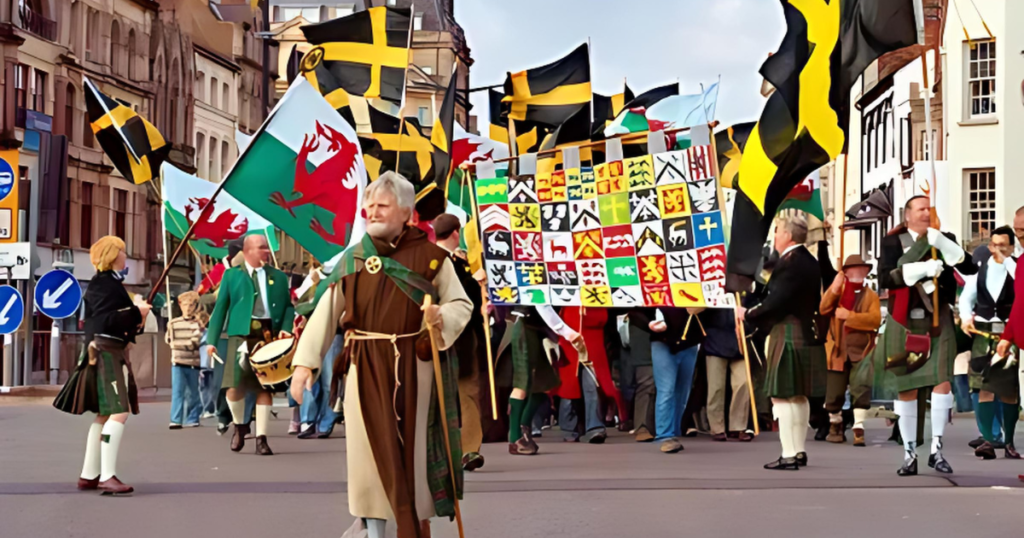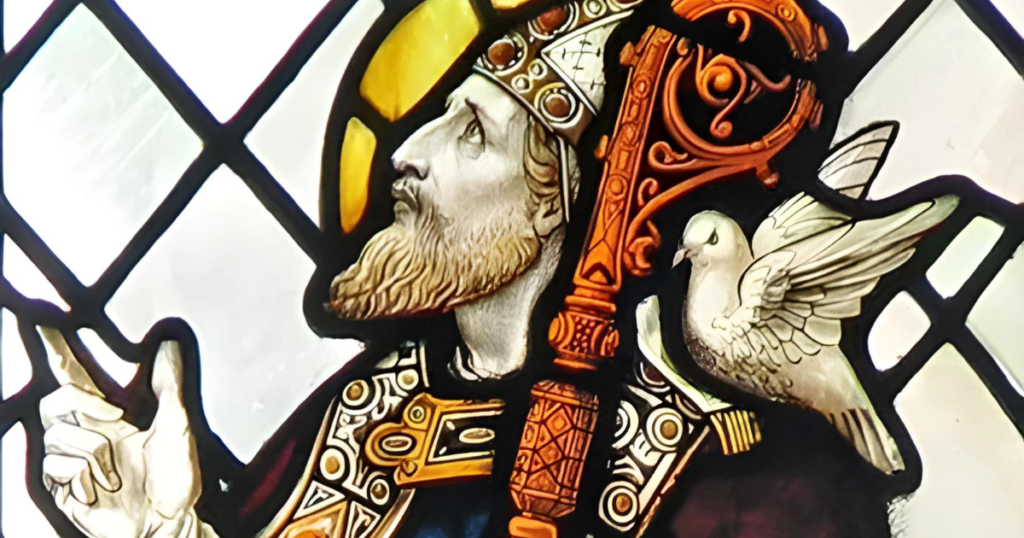Introduction
St. David is the patron saint of Wales and one of the most renowned saints in Britain. He founded several monasteries and churches in southwest Britain in the 6th century and was known for his ascetic lifestyle and missionary work throughout Wales. Let’s take a closer look at the life, legends, and legacy of St. David.
Read More: Digital News Planet.
Who Was St. David?
St. David (known in Welsh as Dewi Sant) was born around 500 AD in Pembrokeshire, Wales. His mother was St. Non, who was also later declared a saint. The identity of his father is uncertain but was said to be a royal prince.
St. David was educated at the monastery of Hen Fynyw under St. Paulinus. He later founded his monastery at Glyn Rhosyn (St. Davids) on the western headlands of Pembrokeshire, which became an important Christian shrine and pilgrimage site.
St. David adhered to an ascetic lifestyle. He and his fellow monks lived frugally, abstaining from beer and wine, and surviving off bread, herbs, and vegetables. They would pray and study scripture relentlessly, working in the fields during breaks.
St. David traveled extensively throughout Wales, particularly the west and southwest areas, preaching and establishing monastic settlements and churches. He is known for spreading Christianity and monasticism across the region during a tumultuous period.
By the 8th century, St. David had come to be widely regarded as the patron saint of Wales. His lasting legacy was the flourishing of Christianity and monasteries in the region. Let’s look at some interesting facts and legends about this beloved saint.
What is St. David the Patron Saint of?
St. David is considered the patron saint of Wales. He helped spread Christianity across Wales and established it in the region. For this major contribution, he was later declared the primary patron saint of the entire country.
In particular, St. David has a strong association with West Wales, where he was born, lived, preached, and founded settlements and churches. Major pilgrimage sites linked to him are found in Pembrokeshire, southwestern Wales.
Beyond Wales, St. David is also considered the patron saint of vegetarians and doves. His ascetic, meat-free lifestyle in the monastery has connected him to vegetarianism. The dove symbol became linked to him through the popular miracle story of his sermon on the riverbank.
When Was St. David Born?

The exact birth year of St. David is not known conclusively, but most scholars place it around the year 500 AD. In terms of rulers and events, this would have been during the late 5th to early 6th century, when the Anglo-Saxon invasion of Britain was ongoing.
According to his birth legend, St. David was born on a cliff during a fierce storm. The site later became known as the Cathedral Close of St. Davids in Pembrokeshire, Wales.
Most accounts suggest St. David lived for over 80 years, up to around 589 AD. This would mean his birth date was likely somewhere between 510 and 520 AD. The early 500s were a turbulent time in Wales and southern Britain amid ongoing Saxon invasions.
How Did St. David Die?
The exact details surrounding St. David’s death are uncertain. However, a couple of traditional accounts give an idea of his passing around the year 589 AD.
One account claims that St. David died while giving a sermon at the Synod of Brevi. After pronouncing “Brothers be ye constant” to his followers, the ground is said to have risen underneath him to form a lofty hill. A dove then descended and settled on his shoulder.
Another account suggests St. David passed away at his monastery of Menevia (St. Davids). He had reportedly reached a very old age of over 100 years old. His last words were said to be: “O Lord, raise me after You.”
Following his death, St. David was buried at St. David Cathedral, which lies at his major monastic settlement site in Pembrokeshire. He was canonized as a saint following his passing. His March 1 feast day continues to be celebrated widely in present-day Wales.
Why is St. David a Saint?
There are several key reasons why St. David came to be declared a saint and the foremost patron saint of Wales:
- He was instrumental in spreading Christianity across Wales during the 6th century at a crucial time when pagan beliefs still existed. He established monasteries and churches, training new priests and preaching extensively.
- He exemplified virtues like asceticism, self-discipline, generosity, and abstinence from alcohol. His lifestyle and teachings reflected key values of Celtic Christianity.
- He was associated with miracles, such as the dove landing on his shoulder and the rising ground during his final sermon. These enhanced his saintly status after his passing.
- Major sites associated with his life became significant pilgrimage centers. St. David in Pembrokeshire became known as Britain’s holiest site for centuries.
- His legacy of spreading monasticism and Christianity endured over time. By the 8th century, he was firmly established as the foremost patron saint of Wales.
For these reasons, St. David continues to be revered as a major saint not just in Wales, where he is the beloved patron, but also more widely in Britain and beyond.
David Day Celebrations in Wales

St. David’s Day on March 1 marks the feast day of St. David, the patron saint of Wales. It is celebrated each year by Welsh communities worldwide with parades, concerts, festivals, feasts, and various cultural events. Some of the common traditions on St. David’s Day include wearing daffodils and leeks, singing traditional songs, reciting poetry, hosting eisteddfod performances, and preparing special dishes like Welsh rarebit. Major public events take place in cities like Cardiff and Swansea. For the Welsh diaspora, it is a chance to celebrate their heritage and history. The date commemorates St. David’s contributions to spreading Christianity and establishing monasteries in Wales during the 6th century. St. David’s Day honors one of Wales’ most iconic historical figures as well as the nation’s culture.
David Miracles and Legends
Numerous miracles and legends became associated with St. David over the centuries. These helped elevate his status as a saint. Some key miracles and stories about him include:
The Dove Miracle
One famous miracle story tells of St. David preaching to a large crowd in Brevi Valley, with a hill on one side and a river on the other. A dove landed on his shoulder as he spoke, and the ground also rose to form a small hill around him so his voice carried further. The dove miracle was one of the first associated with St. David and led to the dove becoming one of his key symbols.
Restoring Sight to St. Paulinus
According to 12th-century writings, St. David encountered St. Paulinus, his old mentor, late in life. St. Paulinus had become blind, but his sight was miraculously restored when St. David spoke to him. Earlier stories just refer to St. Paulinus as St. David’s teacher, without mentioning blindness.
Pilgrimage Cures
The holy wells and sites associated with St. David were believed to have healing powers. Pilgrimages to St. David Cathedral and drinking from his holy well were thought to cure various ailments over the centuries. While not direct miracles by St. David, these pilgrimage traditions contributed to his saintly reputation.
Ascetic Suffering
St. David’s extreme asceticism, like fasting for days while standing in cold river water, was seen by some early writers as a miraculous sign of his holiness. The ability to withstand suffering was believed to be a gift from God. However, later historians are more skeptical of embellished stories of St. David’s mortifications.
David and the Welsh Church
In addition to the legends surrounding him, St. David left a legacy as a key founder of the Welsh Church. Some of his main contributions included:
- Established several important monastery sites, most notably in Glyn Rhosyn (St. Davids, Pembrokeshire), which became the leading Welsh ecclesiastical center for centuries.
- Providing a core training ground for clergy at his monastery, where rigorous religious instruction prepared priests and future bishops.
- Holding synods that established foundational church laws and teachings for Welsh Christianity.
- Shaping the ascetic character and practices of Welsh monasticism.
- Spreading Celtic Christianity more broadly across Wales during a key transitional period from paganism.
- Leaving an enduring spiritual heritage focused on prayer, scripture, generosity, and abstinence – values embodied by St. David that became central to the Welsh Church.

The legacy of St. David helped make the Welsh Church a particularly strong and independent branch within Britain and greater Christendom. His role as patron saint is inextricably tied to the growth of Christianity and monastic tradition in Wales.
Celebrating St. David’s Day in Wales
St. David’s Day on March 1 is the national day of Wales. The celebrations honor St. David himself as well as Welsh culture and history. Common traditions and events include:
- Wearing daffodils and leeks – two iconic national symbols.
- Singing traditional Welsh songs like the national anthem.
- Parades and festivals showcasing poetry, music, and performances.
- Feasts featuring dishes like Welsh rarebit, cawl, and bara brith bread.
- Eisteddfod events highlighting poetry, arts, crafts, and the Welsh language.
- Concerts, recitals, and dances with harps and other instruments.
For Welsh communities worldwide, St. David’s Day represents a chance to celebrate their heritage. The day commemorates their most cherished patron saint while also showcasing Wales’ vibrant culture.
David’s Enduring Legacy
Over 1400 years since his death, St. David remains one of the towering figures in Welsh history and identity. His legacy looms large as:
- The patron saint of Wales – a status solidified by the 8th and 9th centuries when hagiographies were written and pilgrimages boomed.
- A symbol of Celtic Christianity’s influence in Wales through monasteries and ascetic lifestyle.
- The founder of Wales’ preeminent spiritual site at St. Davids, an important destination for pilgrims throughout history.
- An inspiration for medieval Welsh monasticism, which looked back to his asceticism and doctrines.
- A central figurehead for Welsh nationalism and identity, celebrated annually on March 1 across Wales.
For these reasons, St. David continues to hold a special place in Wales today as an integral part of the nation’s spiritual heritage. His life story and miracles have become ingrained in Welsh culture and folklore. The legacy of this pivotal historical saint remains strong in Wales, Britain, and beyond.
Conclusion
St. David stands as one of Wales’ most important historical and religious figures. As the patron saint of Wales, he helped establish Christianity and monasticism in the region during the 6th century. Stories of his miracles and ascetic lifestyle contributed to his status as a beloved saint. His legacy continues to be celebrated each year on March 1, St. David’s Day, when the people of Wales commemorate their national heritage. St. David remains an icon of Welsh identity and a key part of Wales’ spiritual history. His story provides a fascinating insight into the spread of Celtic Christianity, the origins of the Welsh Church, and the enduring role of patron saints.
-
What is St. David best known for?
St. David is best known for spreading Christianity and monasticism across Wales in the 6th century as the patron saint of the country. He established several important monasteries during his life, the most prominent being at St. Davids in Pembrokeshire.
-
Where was St. David born?
St. David was born at the site that became St. Davids in Pembrokeshire, southwestern Wales. He was born in Saint Non around the year 500 AD.
-
How is St. David connected to the dove symbol?
The dove symbol became linked to St. David because of the miracle story involving a dove landing on his shoulder during a sermon in the Brevi Valley. This was one of his early miracles.
-
How did St. David die?
The exact details are uncertain, but traditional accounts suggest St. David died around 589 AD either while giving a sermon or at his monastery at St. Davids. He was over 80 years old.
-
How is St. David celebrated today?
St. David is honored each year on March 1, St. David’s Day, with events and celebrations across Wales. Wearing daffodils and leeks, special meals, concerts, parades, and festivals mark the day.





